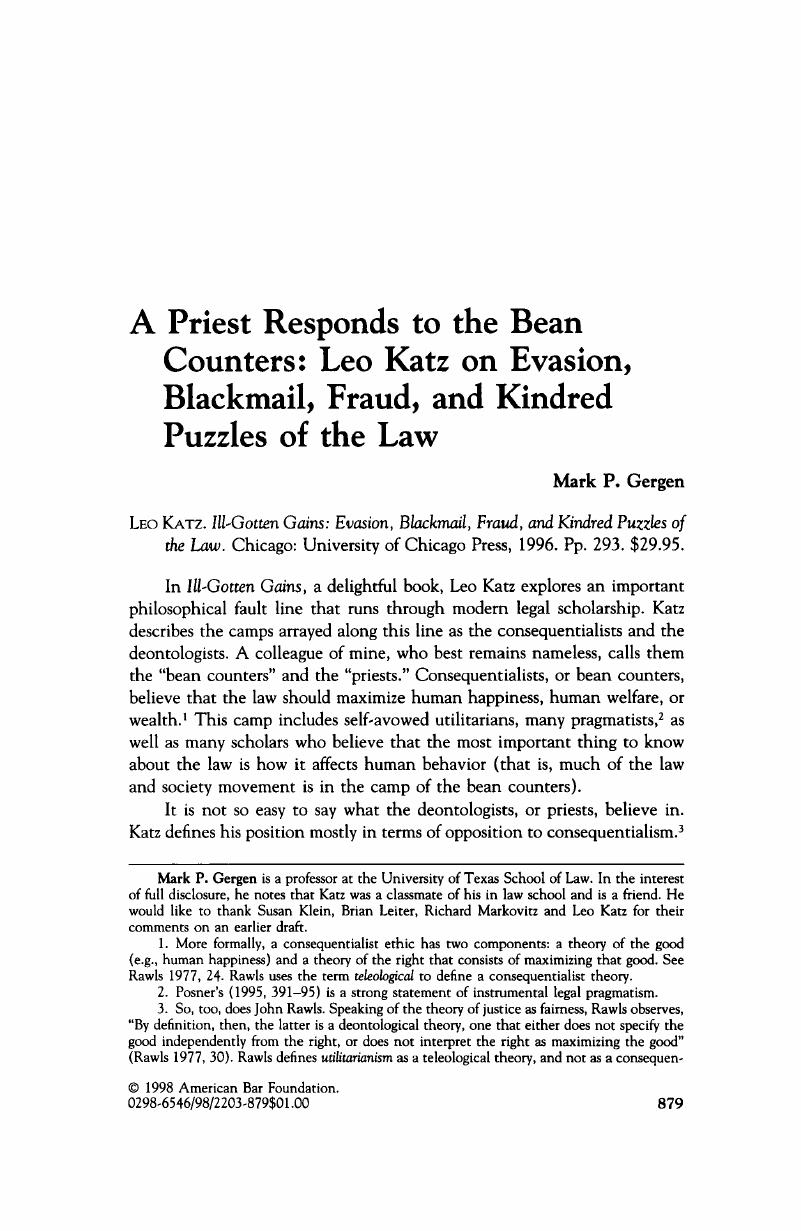No CrossRef data available.
Article contents
A Priest Responds to the Bean Counters: Leo Katz on Evasion, Blackmail, Fraud, and Kindred Puzzles of the Law
Published online by Cambridge University Press: 27 December 2018
Abstract
An abstract is not available for this content so a preview has been provided. Please use the Get access link above for information on how to access this content.

- Type
- Review Essay
- Information
- Copyright
- Copyright © American Bar Foundation, 1997
References
Altman, Scott. 1993. A Patchwork Theory of Blackmail. University of Pennsylvania Law Review
141: 1639–61.Google Scholar
Auerbach, Alan J.
1991. Retrospective Capital Gains Taxation. American Economics Review
81: 167–68.Google Scholar
Auerbach, Alan J., Kotlikoff, Laurence J., and Skinner, Jonathan. 1983. The Efficiency Gains from Dynamic Tax Reform. International Economics Review
24: 81–100.Google Scholar
Barnett, Randy E.
1986. A Consent Theory of Contract. Columbia Law Review
86: 269–321.Google Scholar
Barnett, Randy E.
1992. The Sound of Silence: Default Rules and Contractual Consent. VirginiaLaw Review
78: 821–911.Google Scholar
Becker, Gary. 1974. A Theory of Social Interactions. Journal of Political Economy
82: 1063–93.Google Scholar
Bradford, David. 1996. Consumption Taxes: Some Fundamental Transition Issues. In Frontiers of Tax Reform, ed. Boskin, Michael J., 123–50.Google Scholar
Calabresi, Guido, and Melamed., A. Douglas
1972. Property Rules, Liability Rules, and Inalienability: One View of the Cathedral. Harvard Law Review
85: 1089–1128.Google Scholar
Craswell, Richard. 1989. Contract Law, Default Rules, and the Philosophy of Promising. Michigan Law Review
88: 489–529.Google Scholar
DeLong, Sidney W.
1993. Blackmailers, Bribe Takers, and the Second Paradox. University of Pennsylvania Law Review
141: 1663–93.Google Scholar
Fletcher, George. 1993. Blackmail: The Paradigmatic Crime. University of Pennsylvania Law Review
141: 1617–38.Google Scholar
Gergen, Mark P.
1994. A Cautionary Tale about Contractual Good Faith in Texas. Texas Law Review
72: 1235–75.Google Scholar
Gergen, Mark P.
1995. A Defense of Judicial Reconstruction of Contracts. Indiana Law Journal
71: 45–99.Google Scholar
Gergen, Mark P.
1996a. A Grudging Defense of the Role of the Collateral Torts in Wrongful Termination Litigation. Texas Law Review
74: 1693–1739.Google Scholar
Gergen, Mark P.
1996b. Tortious Interference: How It Is Engulfing Commercial Law, Why This Is Not Entirely Bad, and a Prudential Response. Arizona Law Review
38: 1175–1232.Google Scholar
Gordon, Wendy J.
1993. Truth and Consequences: The Force of Blackmail's Central Case. University of Pennsylvania Law Review
141: 1741–85.Google Scholar
Hardin, Russell. 1988. Morality within the Limits of Reason. Chicago: University of Chicago Press.Google Scholar
Hardin, Russell. 1993. Blackmailing for Mutual Good. University of Pennsylvania Law Review
141: 1787–1816.Google Scholar
Isenbergh, Joseph. 1993. Blackmail from A to C. University of Pennsylvania Law Review
141: 1905–33.Google Scholar
Kahn, Douglas A., and Lehman, Jeffrey S.
1992. Tax Expenditure Budgets: A Critical View. Tax Notes
54: 1661–65.Google Scholar
Landes, William A., and Posner, Richard. 1987. The Economic Structure of Tort Law. Cambridge: Harvard University Press.Google Scholar
Laycock, Douglas. 1985. The Ultimate Unity of Rights and Utilities. Texas Law Review
64: 407–13.Google Scholar
Lindgren, Jim. 1984. Unraveling the Paradox of Blackmail. Columbia Law Review
84: 670–717.Google Scholar
Posner, Richard. 1996. Review of Ill-Gotten Gains, by Leo Katz. New Republic
215, nos. 3-4 (15 July): 38–41.Google Scholar
Slawson, W. David. 1996. Binding Promises. Princeton, N.J.: Princeton University Press.Google Scholar
Surrey, Stanley S., and McDaniel, Paul R.
1985. Tax Expenditures. Cambridge: Harvard University Press.Google Scholar
Sunstein, Cass. 1996. Legal Reasoning and Political Conflict. New York: Oxford University Press.Google Scholar




